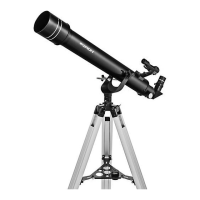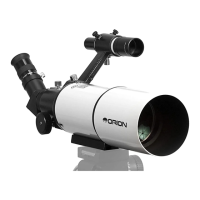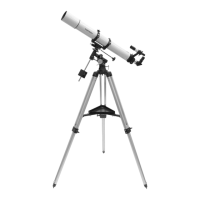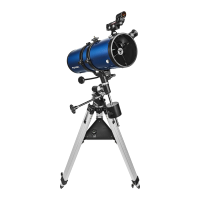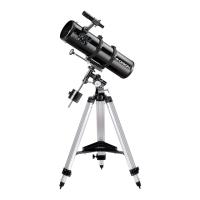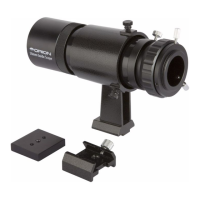7
2. Loosen the counterweight lock knob and slide the counter-
weight along the shaft until the telescope remains in any
given position without tending to drift up or down relative
to the polar axis (Figure 19). Then retighten the counter-
weight lock knob, locking the counterweight in that posi-
tion. If you can’t tell where the balance point is, just set the
counterweight halfway up the counterweight shaft and lock
it there.
The telescope is now balanced.
4. Understanding and Using
the Equartorial Mount
When you look at the night sky, you no doubt have noticed
the stars appear to move slowly from east to west over time.
That apparent motion is caused by the Earth’s rotation (from
west to east). An equatorial mount is designed to compensate
for that motion, allowing you to easily “track” the movement of
astronomical objects, thereby keeping them from drifting out
of the telescope’s eld of view while you’re observing.
An equatorial mount has two perpendicular axes: right ascen-
sion and declination (Figure 18). The R.A. axis, also known as
the “polar” axis, can be aligned to be parallel with the Earth’s
axis of rotation, thus allowing easy tracking of the night sky.
This is accomplished by slowly rotating the telescope on its
R.A. axis. The process of aligning the mount’s R.A. axis with
the Earth’s rotational (polar) axis is called polar alignment.
Polar Alignment
For Northern Hemisphere observers, approximate polar align-
ment is achieved by pointing the mount’s right ascension axis
at the North Star (Polaris). It lies within 1° of the north celes-
tial pole (NCP), which is an extension of the Earth’s rotational
axis out into space. Stars in the Northern Hemisphere appear
to revolve around the NCP.
To nd Polaris in the sky, look north and locate the pattern of the
Big Dipper (Figure 20). The two stars at the end of the “bowl” of
the Big Dipper point right to Polaris.
Observers in the Southern Hemisphere aren’t so fortunate to
have a bright star so near the south celestial pole (SCP). The
star Sigma Octantis lies about 1° from the SCP, but it is barely
visible with the naked eye (magnitude 5.5).
To polar align the Observer 80ST’s equatorial mount:
1. Roughly level the equatorial mount by adjusting the length
of the three tripod legs as needed.
2. Loosen the latitude lock knob (see Figure 11). Turn the lat-
itude adjustment bolt until the pointer on the latitude scale
is indicating the latitude of your observing location (Figure
18). If you don’t know your latitude, you can look it up on
the internet. For example, if your latitude is 35° North, set
the pointer to 35. Then retighten the latitude lock knob.
The latitude setting should not have to be adjusted again
unless you move to a different viewing location some dis-
tance away.
3. Loosen the Dec. lock knob and rotate the telescope optical
tube until it is parallel with the R.A. axis, as it is in Figure
2. The pointer on the Dec. setting circle should read 90°.
Retighten the Dec. lock knob.
4. Loosen the azimuth lock knob at the base of the equatorial
mount (Figure 18) and rotate the mount so the R.A. axis
points roughly at Polaris. If you cannot see Polaris directly
from your observing site, consult a compass and rotate the
mount so the telescope points North. Retighten the azi-
muth lock knob.
The equatorial mount is now polar aligned. From this point
on in your observing session, you should not make any
further adjustments to the azimuth or the latitude of the
mount, nor should you move the tripod. Doing so will undo
the polar alignment. The telescope should be moved only about
its R.A. and Dec. axes.
Figure 11.
Rear view of the equatorial mount, with the two slow-
motion cables attached.
Figure 12. Line up the slow-motion cable thumbscrew with the
groove in the gear shaft, then tighten.
R.A. slow-
motion cable
Slow-motion
cable
Dec. slow-
motion cable
Latitude lock
knob
Thumbscrew
Latitude adjustment
bolt
Gear shaft
Groove
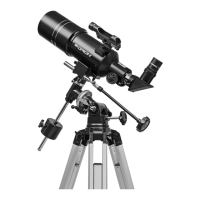
